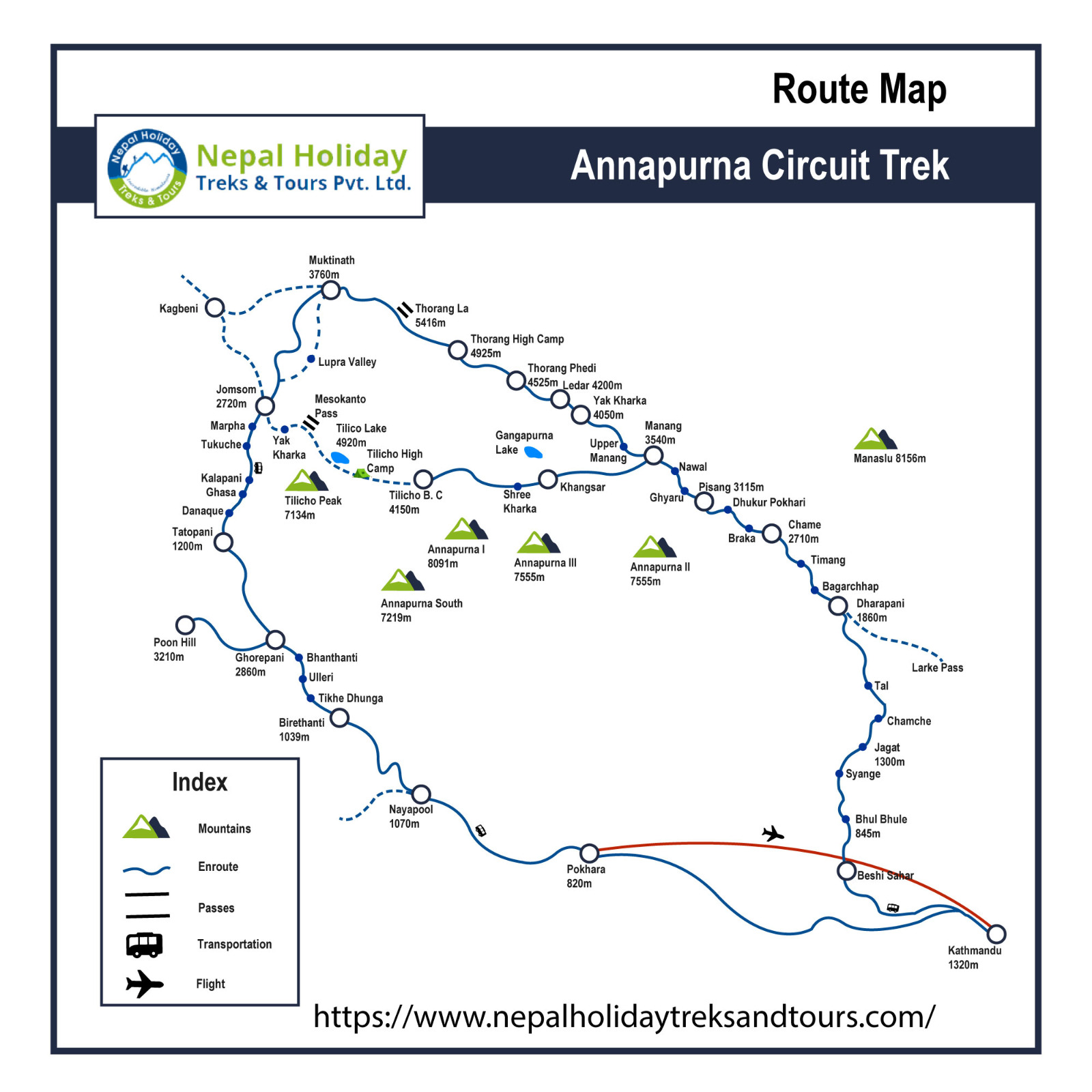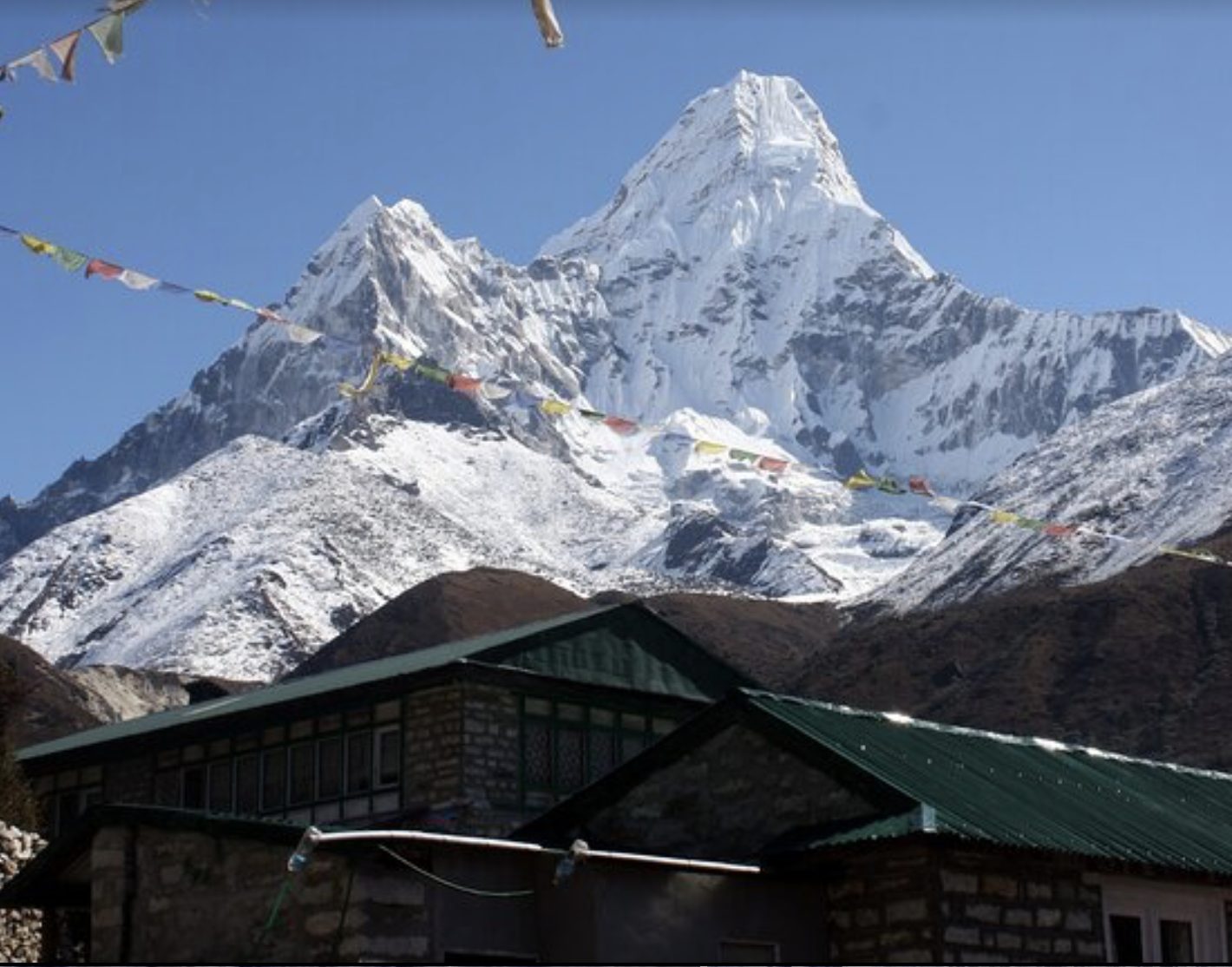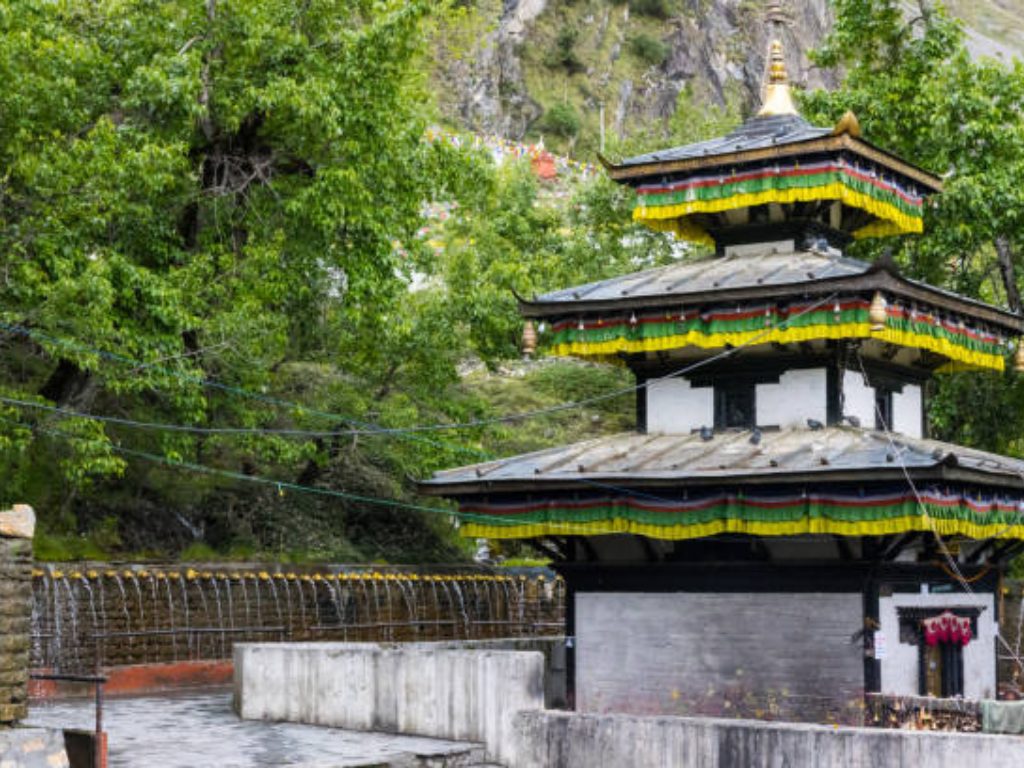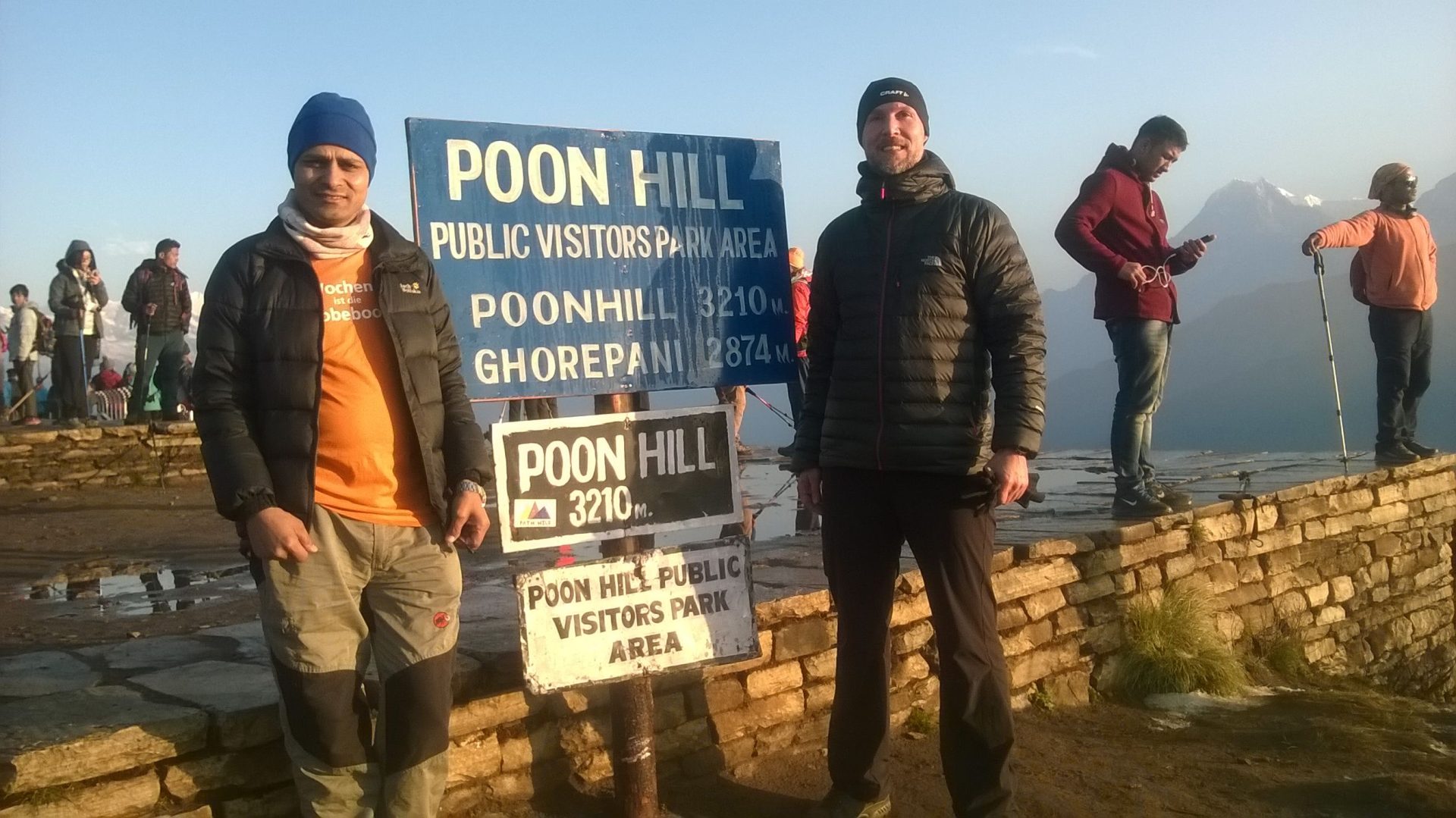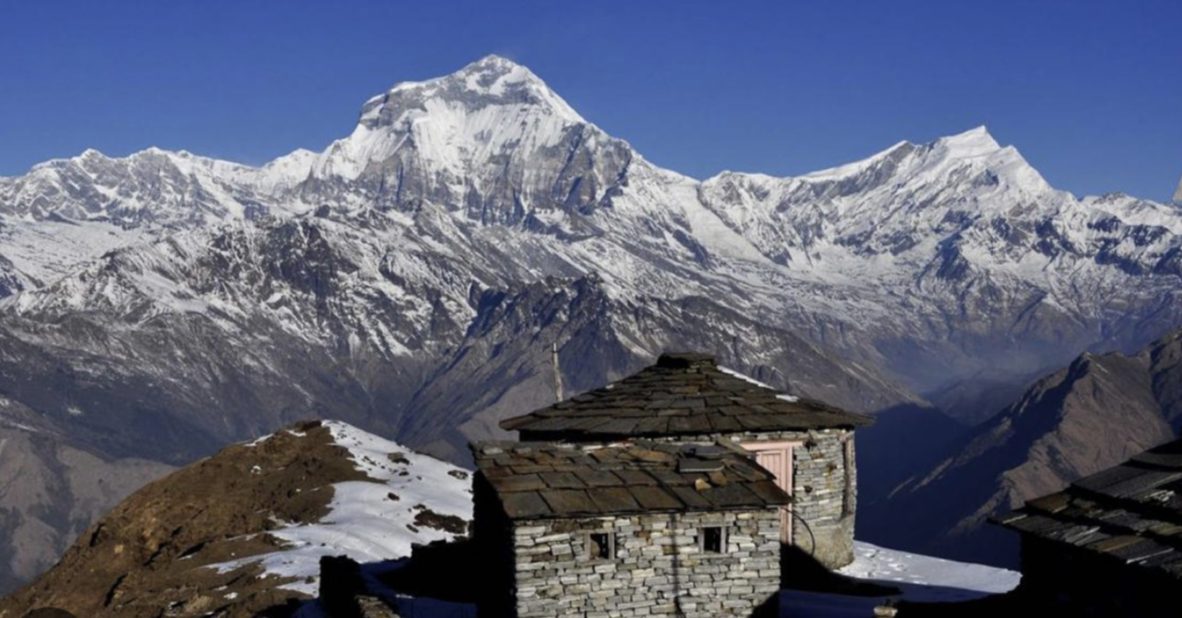Annapurna Circuit Trek Overview
The Annapurna circuit trek is one of the most renowned and adventurous treks in the world, that takes you through some of the most breathtaking landscapes including the Annapurna Massif which is home to several of the world’s highest peaks, such as Annapurna Ⅰ (8091 m), Annapurna Ⅱ (7937 m), Annapurna Ⅲ (7555 m), Annapurna Ⅳ (7525 m), and Annapurna south (7219 m). The trek offers stunning views of the Himalayan landscapes and diverse cultures of the local communities, and chance to
experience the beauty of the Nepalese countryside. Annapurna Ⅰ, stands at an elevation of 8091m, is the 10th highest mountain in the world and considered the main peak of the Annapurna Massif. The historic ascent was took place in 1950 by a French expedition led by Maurice Herzog and was the first 8000 m peak ever climbed.
Generally, the traditional Annapurna circuit trek starts in the town of Besisahar. From there, you will gradually ascend through various villages, river valleys, terraced fields, and rhododendron forests. The highest point of the trek is the Thorong La Pass at 5416 m. The pass offers impressive panoramic views and a sense of achievement upon reaching the highest point of the trek. After crossing the pass, the trail descends through the Mustang region , known for its distinct Tibetan- influenced culture and unique landscapes. The ancient monasteries, red cliffs, and cave dwellings add to the region’s mystique. Eventually, the trek concludes in the town of Nayapul. Overall, Annapurna circuit trek is one of the challenging and popular trekking routes, attracting mountaineers and trekkers from all over the globe. It offers an unforgettable adventure, combining natural beauty , cultural experiences, and a sense of achievement as you complete the challenging journey through the Himalayas.
What to expect at the Annapurna Circuit Trek?
The Annapurna Circuit Trek is an opportunity to experience panoramic views of the Annapurna and Dhaulagiri ranges, beautiful forests of variegated species, terraced fields, and high-altitude deserts. From subtropical valleys through alpine meadows, the trek offers breathtaking scenery as it crosses a variety of climatic zones. The peak of the trek is at Thorong La Pass, offering sweeping views of the surrounding peaks and valleys.
Sweeping views of the Annapurna Circuit Trek
The cultural experiences along the Annapurna Circuit are indeed rich and varied. You will be trekking through villages like Manang, Marpha, and Pisang, where cultures of Nepali, Gurung, and Tibetan amalgamate. Buddhist stupas, monasteries, and traditional stone houses outline the route, giving insights into spiritual and cultural practices of the local communities. You get to meet friendly locals, learn about their customs, and grow more appreciative of the region’s heritage.
learn about acute mountain sickness in the Himalayan rescue association on Annapurna Circuit Trek
Acute Mountain Sickness is the factor of concern for trekkers in higher altitudes. The trek to Thorong La Pass at over 5,400 meters raises the stakes for AMS to a level where headaches, dizziness, nausea, and a host of other symptoms can start to occur. To avoid getting AMS, trekkers need to acclimatize themselves properly, ascend gradually, and stay hydrated. The Himalayan Rescue Association gives good information on AMS and supports the recognition of symptoms and knowing when to go down. It is very important to be aware of the risks of AMS and take precautions during the trek
Permits During the trekking
To trek in the Annapurna region, you will need two main permits:
1) The Annapurna Conservation Area Permit (ACAP)
2) The Trekkers’ Information Management System (TIMS) Card
2) Lodging and foods
Annapurna Conservation Area Permit (ACAP)
The Annapurna Conservation Area Permit (ACAP) is required by all travelers who are traveling to the Annapurna region. The cost of the permit is as follows:
For foreigners (non-SAARC countries): NPR 3,000 per head
For SAARC nationals: NPR 1,000 per head
For Nepali: NPR 100 per head
You can obtain the ACAP permit from:
Nepal Tourism Board (NTB) Office in Kathmandu or Pokhara
Checkpoint at entry points of the Annapurna region
The trail to Annapurna circuit is well – served with teahouses and lodges, providing accommodation and meals for trekkers. You can generally find basic but comfortable lodging and a variety of food options ranging from local Nepali dishes to International cuisines.
Best time to trek
The best time to undertake the Annapurna circuit trek is during the spring (March- May) and autum (September- November) seasons. The temperatures are mild, the weather is relatively unchanged, the clear skies provide astonishing mountain views, and the day time walking temperature are also the most pleasant.
Travel Insurance for a Safe Annapurna circuit Trek
Any trek in Nepal, including the Annapurna circuit Trek, needs travel insurance. The trek includes high altitude trekking, which may be physically challenging and dangerous. Travel insurance can cover you financially in the event of an accident, a medical emergency, a flight cancellation or delay, or lost or stolen luggage. When buying travel insurance for the Annapurna circuit trek, ensure that it covers high- altitude trekking and emergency helicopter evacuation.
Guide and Porters for the safety on Annapurna circuit Trek
While the Annapurna circuit can be done independently, it’s helpful to hire local guides or porter. They can provide you valuable insights into the local culture, traditions, and history of the Annapurna region. They can explain the significance of monasteries, festivals, and other cultural aspects you encounter along the way. Moreover, they are familiar with the trail conditions and alternate routes. Similarly a porter carries your heavy backpack, and allowing you to trek with a lighter load. Therefore, you can join Nepal holiday treks and tours Pvt. Ltd. for hiring a highly experienced, helpful, friendly, and English speaking, licensed trekking guide and porter with their insurance.
Altitude Sickness During the trekking
Generally altitude sickness occurs when you travel to a high altitude too quickly. Headache, nausea, tiredness etc are the symptoms occur when your body tries to adjust to the lower air pressure and lower oxygen levels at high altitudes. When it comes to this illness, one should be pro-active and notify the guide as soon as possible.
Preventing Altitude Sickness (AMS):
- Rest Well: Ensure that you rest well before starting your trek.
- Stay Hydrated: Continue drinking plenty of water during the journey.
- Balanced Nutrition: Maintain the balance of salt and sugar through proper eating habits and not skipping meals.
- Keep Warm: Layer up to remain warm without profuse sweating.
- Controlled Breathing: Breathe deeply and steadily from your diaphragm to maximize lung capacity. Maintain a comfortable walking speed that will allow for controlled breathing. Nasal breathing avoids drying your throat—wearing a muff or scarf in high altitudes might be of use.
- Pace Yourself: It’s not a competition. Pace yourself with a maintainable and Server consistent pace instead of exhausting yourself too early and taking many rest stops. Stop and admire the stunning views.
Best time for Annapurna Circuit Trek
The best time for the Annapurna Circuit Trek is in the spring-March to May-and in autumn-September to November-of the year. This time of the year presents the best climate conditions, including clear skies and stabilized temperatures without much rainfall. During springtime, the flowers are in full bloom, which includes the amazingly beautiful rhododendons, while the autumn season can be crisp, dry, and ideal for trekking. The view of the Annapurna and Dhaulagiri mountain ranges is eminently visible in both seasons, with stunning panoramic views, hence the most popular times for trekkers.
In contrast, winter-December to February-can be pretty harsh on the circuit, especially at higher altitudes where the temperature can considerably go down, making the trek quite challenging. The trail is covered by snow and ice that might block some areas, including Thorong La Pass. Generally, summer or the monsoon season is not preferred because heavy rainfall makes trails slippery, causes landslides, and visibility is poor. If you choose to trek during these months, it is vital to be prepared for more difficult conditions and possible delays. Spring and autumn remain the prime seasons for the best experience on the Annapurna Circuit.
Annapurna Circuit Trek Highlights
- Glorious views of snow- capped peaks, including Annapurna ? (8091 m), Manaslu (8163 m),
- Dhaulagiri (8167 m) and many others
- We will provide you with a (20 degree sleeping bag) and a duffel bag for the trekking excursion, but you must return them after completing the trek.
- Reaching the highest point of the trek- Thorong La Pass (5416 m)
- Relaxing your tired muscles in Natural hot springs at Tatopani
- Visiting Muktinath temple, a sacred pilgrimage site for both Hindus and Buddhists
- Explore the culturally and spiritually significant temple and the beauty of its surrounding landscapes
- Explore Mustang region and experience the Tibetan- influenced culture and unique landscapes
- Pass through red cliffs and visiting ancient monasteries and cave
- Encounter traditional villages, high-altitude desert- like terrain, lush green forests with rhododendron and oak trees, and deep gorges
- Opportunity to experience warm hospitality and culture and traditions of different ethnic groups including Gurungs, Thakalis, and Manangis
- Interact with the welcoming locals and learn about their way of life
- Annapurna Base Camp (4130 m)
Important Notes
Nepal Holiday Treks and Tours Pvt. Ltd. has years of expertise in the field of Himalayan trekking and can curate unforgettable experiences for adventurers like you. In order for trekkers to have a really comfortable and pleasant Everest Base Camp Trek, we are offering different optional services as per your need.
Optional Add-Ons Available:
Required Experience:
This trek is ideal for active trekkers who can hike 6 to 7 hours a day carrying a light daypack. On certain days, the trekking is longer and the altitude increases the difficulty level of trekking. The trails are generally good, but there could be boulder and uneven patches in between.
Itinerary and Schedule: We try to follow the itinerary planned; yet trekking in distant mountain regions means uncertainty. Factors such as weather and trekkers’ well-being may make readjustments necessary. Your guide and Sherpa crew will try to stick to the trail as designed but flexibility is a must. Your safety is our topmost priority and also to get you back to Kathmandu before your scheduled departure.
What will the temperature be like during trek?
Weather conditions can vary significantly depending on the season and can change rapidly, especially at higher elevations. If your trek takes you above 3,000m, you should be prepared for temperatures ranging from -10°C to 25°C in a single day. It’s essential to have proper protection against sun exposure and strong winds. For helpful weather insights, refer to reliable source. Feel free to reach out to us for a recommended packing list tailored to your trekking itinerary.
How much money should be we bring?
You’ll require Nepali Rupees for any expenditure not covered by your package itinerary. Such costs might include bottled water, night hot shower, extra snacks, extra hot drinks, repairing or replacing equipment, battery charging, souvenirs, and tips. In case you want to shop, Thamel is an excellent place to shop on your last day. You are welcome to come to our office prior to your trek for individual counsel and assistance with money exchange.
Electricity, telephone, and internet access are available at most lodges and guesthouses along the Annapurna Circuit trek , but with some additional charges. While the trek itself does not have widespread access to electricity, many lodges rely on solar power or generators to provide energy. You can recharge your devices like cameras, mobiles, and laptops at these places, although it usually comes at an extra cost. If you need to make phone calls or access the internet, some accommodations offer limited telephone and Wi-Fi services. You can obtain an internet password from the lodge, but keep in mind that these services typically incur additional fees.
Fill your life with adventures, not things. Have stories to tell, not stuff to show. Hurry up! Adventure is waiting for you and mountains are calling you.
This trip is fully customization. Importantly, this trip is available on both a fixed departure and a private group basis. Moreover, we can also customize the trip as per your needs, please contact us at Whatsapp (+977-9843770916) or email us at [email protected]. Let us know how we can help you, and we will do our best to give you the best customer service you’ll get anywhere else.
Furthermore, Nepal holiday treks and tours Pvt. Ltd. is a reputable and reliable company serving relentlessly in the field of tourism to fulfill the dreams of diverse adventure seekers around the globe into reality where they can feel most alive. So, we recommend you to reserve seat for yourself by booking with us right away for a wonderful and unforgettable trip experience.
Annapurna Circuit Trek Itinerary
Expand allDay 1: Kathmandu to Nadi Bazar ( 9,30 m) ( 8 hrs driver)
we are travel by drive from Kathmandu to Besi Sahar, located at 9 meters, takes approximately 7 hours by local bus, covering a distance of 185 kilometers. The journey winds through mountainous roads, passing small towns and rural villages, offering scenic views of the hills and rivers. The road can be bumpy and narrow, contributing to the longer travel time, as the bus makes several stops along the way. Besi Sahar is the gateway to the Annapurna region, serving as the starting point for treks like the Annapurna Circuit.The best seasons for the Annapurna Circuit Trek are autumn (September to November) and spring (March to May). During these times, the weather is stable, offering clear skies and moderate temperatures. Autumn provides breathtaking views of the mountains, while spring showcases vibrant rhododendron blooms
Day 2: Trek from Bulbule to Bahundada (1310 m)
Our first day of trekking begins in Besi Sahar, where the trail is an easy, flat walk with no significant uphill or downhill sections. Along the way, we’ll observe the daily lives of local people working in the fields, offering a glimpse into their rural routines and lifestyles.
Day 3: Trek to Chamje
Today we shall cross the first suspension bridge over the Marshyandi River and encounter the beautiful,
tall and gorgeous waterfall. We then follow the river to the stone village of Jagat (1300m) before climbing
through forest to Chamje at 1400 meters.
Day 4: Trek to Bagarchhap ( 2,160 m)
Today we have rocky trail making along the Marshyandi River climbing steadily uphill to Taal, the very first village to Manang district. As soon as we cross the flat surface village we have up and down trail to
Dharapani (1860m). The people in this area are influenced with the Tibetan life style.
Day 5: Trek to Chame (2670 m) (6 hours)
Cham-e, the headquarters of Manang District, is a beautiful place situated among nature. It offers a relaxing hot spring for trekkers and provides a stunning view of the surrounding Himalayas that includes Lamjung Himal, Annapurna II, and Annapurna IV (7,525m). This location offers a very great opportunity to rest while enjoying spectacular mountain panoramas.
Day 6: Trek to Pisang (3200 m) (5-6 hrs)
A steep and narrow path through a very dense forest will bring us to the dramatic curved rock face, rising
1500m from the river. This is probably the steepest part of the Marshyangdi Valley, so steep that the trail is carved into the vertical rock. After passing this last bit of rock, the valley opens up with majestic vistas. And right where the valley widens stands the Paungda Danda, a massive sloping rock face that rises over
1500m above the trail. We trek for a while before reaching Lower Pissang where we spend the night.
Day 7: Trek to Manang via ngwal (3540 m) (6-7 hrs)
Today we have two routes to Manang, one that takes us to the trail up to Upper Pisang via Ghyaru. This
trail has the excellent views of the beautiful landscape and the mighty mountains mount Annapurna and
Pissang (6091m). And the other one goes down to southern route of Marshyandi River by Hongde with its
airstrip that involves lesser climbing comparatively to Northern route. The choice is yours, since we meet
up at Munchi whichever route we take. We shall be noticing a contrast in the landscape and vegetation
from today onwards. The cold and dry climate also creates a much harsher environment.
Day 8: Acclimatization Day at Manang
We need to stay fit for our next day trip so, on this day also we shall be doing continuous day walks and capture the magnificent views around the village. We have the option to go for a hike to Gangapurna Lake
or Braga village and visit the oldest Braka Gumba.
Day 9: Trek to Yak kharkha (4050 m) or Ledar (4200 m) ( 4-5 hrs)
Today we slowly climb up to the village of Tenki and continue walking across Marshyangdi Vallley turning
northwest to the valley of Jhorshang Khola. The trail passes through the pastures and few scrubs of
juniper trees. On the way we might be seeing horses and yaks grazing.
Day 10: Trek to Thorong Phedi or Throng high Camp (4925 m) (4-5 hrs)
Today we have an upward following trail to Throng Phedi (4525m). On the way we will be seeing one of
the best views of Mt. Gundang, Mt. Syagang, Thorung Peak and Mt. Khatungkan. We shall be taking rest
in either Throng Phedi or at the High Camp.
Day 11: Trek to Muktinath via Throng La pass (5416 m) ( 7 hrs)
Crossing Throng la pass is our main goal for the day so we are waking up early in the morning and walk
ahead with the lights on. After making through Throng La pass we shall reach in Muktinath (3760m) in a
few hours of walk. It is believed that all our sorrows and pain are relieved when visiting this very temple.
The place is surrounded with several other monasteries as well.
Day 12: Trek to Kagbeni (2810 m) ( 4 hrs)
Since we are on the other side of Manang most of the land we see will be dry and looks somewhat like the
desert. We will continue our trek walking by the bank of Kaligandi River. Most of the time, we will descend with closer view of stupas and really old traditional house and civilization of Mustang.
Day 13: Trek to Marpha (2670 m) (4 hrs)
Descending from Kagbeni village we reach Marpha. The barren landscape of this area resembles Tibet.
Marpha is also famous as the apple in Nepal where one can enjoy different items made from apple like
apple pie, and wines. Apple Brandy is another local specialty that we may be lucky enough to taste.
Day 14: Trek to Larjung (2550 m) (4-5 hrs)
This trail follows the Kali Gandaki River through a nice valley. While walking, we will be able to enjoy spectacular views of Annapurna I (8,091m) and other surrounding landscapes such as lush vegetation, terraced fields, and dramatic mountain scenery. This section offers a picturesque and peaceful trek along the river.
Day 15: Trek to Kalopani (2530 m) (5-6 hrs)
Today will be another fantastic day for the trek, as we will be passing through the traditional village of the
ethnic Thakali people. Also we will be seeing panoramic views of Dhaulagari, Tukuche, Nilgiri, Fang and
Annapurna I mountains. And in our surroundings will beFurther up the trail, we reach picturesque villages to behold, showing culture and friendliness from the local people. Then, rest stops in Ghasa, a nice valley with serene beauty and peaceful surroundings, will be a perfect place to rest for a while on this journey. lots and lots of apple garden.
Day 16: Trek to Ghasa (2010 m) ( 3-4 hrs)
Further up the trail, we reach picturesque villages to behold, showing culture and friendliness from the local people. Then, rest stops in Ghasa, a nice valley with serene beauty and peaceful surroundings, will be a perfect place to rest for a while on this journey.
Day 17: Trek to Tatopani (1190 m) ( 4 hrs)
We will continue beating our feet towards Tatopani. On our way we will emerge into subtropical forests,
lush with vegetation and see power house that supply regular electricity in this area. In the end reaching
Tatopani we get to relax in hot water.
Day 18: Trek to Ghorepani (2880 m) ( 7 hrs)
The trek today leads through the rhododendron forests with a terraced farmland surrounded with glowing
mountains.
Day 19: Trek to Poon hill (3193 m) to Tadapani (2630 m) (6 hrs)
Today we have early morning sunrise to catch up at Poon hill. From here we will be able to get a close up
look at most of the mountains including Annapurna and Dhaulagiri ranges. After taking few photos and
sight-seeing of the mountains we head back to Ghorepani and then head towards Tadapani.
Day 20: Trek to Chomrong (2170 m) (5 hrs)
We have a gradual walk of around 5 hours to Chomrong. Chomrong is a large Gurung village at the
corridor of Annapurna Sanctuary. The village offers the close up view of Annapurna South (7,219m),
Fishtail (6,993m).
Day 21: Trek to Bamboo (2310 m) (5 hrs)
We descend via 2500 stone steps and cross the bridge above Chhomrong Khola. From here it is an uphill
climb to Sinuwa. Next, we pass through a beautiful forest to Kuldihar followed by an easy downhill walk to
Bamboo.
Day 22: Trek to Deurali (3230 m) ( 4 hrs)
Deurali is across the arduous moraine intercepted by creeks with ice deposition. We have bamboo forest
and few steep sections and open views of the glacial river to cross.
Day 23: Trek to ABC (4200 m) (6 hrs)
The trail to Annapruna Base Camp climbs gradually to the snowfield and the edge of glacier. Today we
have the wonderful views of the majestic Machhapuchhre aka Fishtaill along with Mt. Hiunchuli, Annapurna South, Annapurna I, Annapurna III, Gandharvachuli and Gangapurna which is certainly a rewarding experience.
Day 24: Trek to Bamboo ( 4,130 m) (7 hours)
After reaching Annapurna Base Camp (ABC) at 4,130 meters, we begin our descent towards Bamboo (2,340 meters). The trail is relatively easy, with a gradual downhill route, making it a manageable day. The trek takes approximately 4 to 5 hours, allowing us to enjoy the changing landscapes as we descend through the forest and villages.
Day 25: Trek to Jhinu Dada (1780 m) ( 5-6 hrs)
After reaching Jhinu dada today we shall have the opportunity to enjoy the natural hot springs which is just a few minutes downhill walk from our tea house to soothe our aching body.
Day 26: Trek to Pothana (1990 m) ( 5 hrs)
After breakfast, from Jhinu Danda, we trek to Pothana on a path that goes up and down through small villages and dense jungle, offering some fantastic views. We will be trekking through quiet natural environments and having great opportunities to witness the culture while walking.
Day 27: Trek to Phedi (1130 m) and drive to Pokhara by private car
Today we have the easiest path just for few hours and take the vehicle from Phedi and end the trek at
Pokhara.
Day 28: Drive from Pokhara to Kathmandu
We take the tourist bus to Kathmand
If the above Everest Base Camp Trek itinerary does not meet your needs, we can design individualized travel plans based on your preferences and specifications.
Plan My TripAnnapurna Circuit Trek Cost Includes
- Three times three meals a day- Breakfast, Lunch, Dinner and 3 cups of tea/Coffee a day during the trek.
- Accommodation in teahouse/ lodge during the trek.
- In a day time tea break with cookies every day.
- Nepal Holiday Treks and Tours, (-20 degree sleeping bag) and a duffel bag for the trekking, but you need to refund to the office after the trip.
- Fresh fruits after dinner every night as dessert during the trek.
- Annapurna conservation area permit and TIMS Card (Trekkers information management system).
- Kathmandu to Nadi bazar by local transportation, Phedi to Pokhara by local transport, and Return Back to Kathmandu by tourist Bus.
- Accommodation at Pokhara in tourist 3 Star B/B hotel for 1 night.
- You will be under observation with a pulse oximeter to have your oxygen levels and heart rate measured twice a day during the trek. This is to catch the signs of Altitude Mountain Sickness (AMS) early, thus making trekking safer.
- An experienced, helpful, knowledgeable, friendly, English speaking well trained, government license holder Trekking Guide with all his salary, food, Drinks, accommodation, equipment, transport, and insurance.
- Normal First aids kit box.
- All taxes and company service charge.
- Arrangement of Emergency Helicopter service (paid by your travel insurance company).
Annapurna Circuit Trek Cost Excludes
- International airfare and visa fees.
- Accommodation in Kathmandu and lunch and dinner in Pokhara.
- Personal expenses of bar and beverage bills, wifi, hot shower, water bottle, extra porters, laundry or any other things which are not mentioned by the company.
- Your personal trekking gears.
- Extra nights in a certain destination due to weather, flight delays, strikes or health issues.
- Your travel insurance which should include the emergency rescue(must have).
- Tips for your guide and porters which is mandatory.
- A strong, helpful, porters with proper safety equipment and walking equipment his salary, food, drinks, accommodation, insurance, (one porter for two people he will carry bag pack max 20-25kg).
- Extra expenses due to any other events you want to attend.
Upcoming Departures
Customer Reviews
Write a ReviewAnnapurna Circuit Trek Equipment Lists
General info:
- Sleeping Bag and duffle bag: Four-season sleeping bag with a rating of -20°C by company after you have to refund on company.
- Insulated Jacket: A puffy and warm down jacket suitable for winter by company after you have to refund on company.
- Daypack: 25-30 liter backpack rain cover to carry one’s daily essentials
Clothing:
- Thermal base layers
- Trekking shirts (quick-dry)
- Fleece jacket and down jacket
- Waterproof jacket and pants
- Trekking trousers
- Gloves (inner and outer)
- Warm hat and sun hat
- Trekking socks
Footwear:
- Sturdy trekking boots
- Camp shoes/sandals
- Gaiters (optional)
Accessories:
- Trekking poles
- Backpack (50-60L) and daypack (20-30L)
- Sunglasses (UV protection)
- Headlamp with extra batteries
- Water bottles and purification tablets
Similar Tours
Short Manaslu Tsum Valley Trek
An 18 days trek, the Short Manaslu and Tsum Valley Trek engages trekkers to an adventure close to Mt....
Gokhyo-Renjola Pass trek
Gokhyo-Renjola Pass trek Your getaway from the typical trekking route to Everest Base Camp is the Gokyo Renjo-La Pass...
Jomsom Muktinath Trek
Nepal is a stunning country in the Himalayas with magnificent mountains. These mountains’ foothills make for ideal walking terrain....
Ghorepani-Poonhill-Ghandruk Trek
The sheer grandeur of Nepal’s many landscapes and geographical features makes it unimaginably beautiful. There are many interesting, quaint,...
Khopra Danda Trek with Khayer Lake
One of the most beautiful trekking routes in the Annapurna region is the Khopra Danda Trek. For trekkers who...

